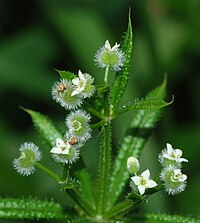Galium
| {{{name}}} LATINNAME
|
'
| ||||||||||||||||||||||||||||||||||||||||
|---|---|---|---|---|---|---|---|---|---|---|---|---|---|---|---|---|---|---|---|---|---|---|---|---|---|---|---|---|---|---|---|---|---|---|---|---|---|---|---|---|---|

|
|
| |||||||||||||||||||||||||||||||||||||||
| |||||||||||||||||||||||||||||||||||||||||
| Standard Cyclopedia of Horticulture |
|---|
|
Galium (Gallon was the name of a plant mentioned by Dioscorides as used in curdling milk. G. verum is locally used abroad for this purpose). Rubiaceae. Bedstraw or Ladies' Bedstraw, so-called because of the legend that one of these plants was in the hay on which the mother of Christ rested. Mostly weak or slender herbaceous plants with square, often barbed stems, and whorled leaves. Flowers very small, perfect, epigynous; calyx almost or quite obsolete; corolla gamopetalous, rotate, deeply 4-parted; divisions in our species acute or acuminate; stamens 4; ovary inferior, 2-cclled, forming a 2-lobed, 2-seeded, dry, indehiscent fr.; the lobes nearly globular. —About 220 species in various parts of the world. Noted for the recurved-scabrous sts. of many species, mathematical habit due to the whorled lvs., and the fine fluffy fls. The profuse-flowering species noted below are often used in rockeries and flower-beds for the regular but soft and filmy effect, which is similar to that of gypsophila. As cut-fls., they are used to lighten the effect of heavier fls.
|
Cultivation
- Do you have cultivation info on this plant? Edit this section!
Propagation
- Do you have propagation info on this plant? Edit this section!
Pests and diseases
- Do you have pest and disease info on this plant? Edit this section!
Species
Source: Wikipediawp:
Gallery
If you have a photo of this plant, please upload it! Plus, there may be other photos available for you to add.
References
- Standard Cyclopedia of Horticulture, by L. H. Bailey, MacMillan Co., 1963

